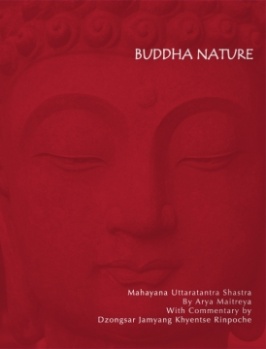Buddha-Nature: Mahayana-Uttaratantra-Shastra (Khyentse Commentary)
No edit summary |
No edit summary |
||
| Line 6: | Line 6: | ||
}} | }} | ||
|FullTextRead=No | |FullTextRead=No | ||
|BookEssay=Based on teachings given by Dzongsar Khyentse Rinpoche in Dordogne, France in 2003-2004, this commentary contains side-by-side copies of the translations from | |BookEssay=Based on teachings given by [[Dzongsar Khyentse Rinpoche]] in Dordogne, France in 2003-2004, this commentary contains side-by-side copies of the translations of the ''The Mahayana Uttaratantra Shastra'' from [[Buddha Nature: The Mahayana Uttaratantra Shastra|Rosemarie Fuchs]] and Ken Holmes, ''[[The Changeless Nature]]'' together with the Tibetan verses. | ||
The book includes a lengthy question and answer section organized around the chapters of the root text, but found at the end of the book. Also included are a Tibetan-Sanskrit-English glossary and an index. | The book includes a lengthy question and answer section organized around the chapters of the root text, but found at the end of the book. Also included are a Tibetan-Sanskrit-English glossary and an index. | ||
Revision as of 16:15, 3 April 2019
Arya Maitreya’s Mahayana-Uttaratantra-Shastra is one of the most important teachings on buddhanature and enlightenment. It is revered by buddhist masters as a very special text, one of the five great teachings given by Lord Maitreya to Asanga, and part of the third turning of the wheel of the Dharma. Within the traditional buddhist shedras for monastic education, it is often taught as the final text in the curriculum, and many masters say it can be considered a bridge between the sutras and tantra. It provides an important philosophical foundation for understanding the workings of the buddhist path, particularly for Vajrayana practitioners. We are particularly fortunate to have these teachings by Dzongsar Khyentse Rinpoche, rich with his usual clarity, warmth, humour and wisdom because, despite its beauty and profundity, this text is rarely taught in the West, and there are few translations.
Rinpoche gave these teachings on the Uttaratantra at the Centre d’Etudes de Chanteloube in Dordogne, France during the summers of 2003 and 2004, after completing a four-year teaching cycle on Chandrakirti’s Madhyamakavatara. He has often emphasised the value of a grounding in the Madhyamika or ‘Middle Way’ philosophy of emptiness, as without this foundation beginners can easily misunderstand Buddha’s teaching that all sentient beings have buddhanature. For example, many of us who have grown up in a Western cultural context can easily confuse buddhanature with ideas like God or a personal soul or essence. These teachings allow us to dispel these kinds of misunderstanding. And despite their very different presentations, both the Madhyamika and Uttaratantra are teachings on the buddhist view of emptiness. As Rinpoche says, “You could say that when Nagarjuna explains the Prajñaparamita, he concentrates more on its ‘empty’ aspect (“form is emptiness” in the Heart Sutra), whereas when Maitreya explains the same thing, he concentrates more on the ‘ness’ aspect (emptiness is form).” In showing us how emptiness and buddhanature are different ways of talking about the same thing, this text gives us the grounding we need to understand buddhanature.
In this way, the Uttaratantra gives us another way to understand the Four Seals that comprise the buddhist view, which Rinpoche teaches in his book “What Makes You Not a Buddhist.” It also offers a way to make sense of what modern physics has discovered about the magically “full” quality of “empty” space (e.g. vacuum particles and quantum optics). But like all buddhist philosophy, it is not intended simply to provoke an academic discussion that we leave behind as we return to our everyday lives. It is taught as a path for us to attain liberation. For practitioners, the Uttaratantra clearly explains what it means to accumulate merit and purify defilements, and it offers a safety net to protect our path from falling into all-too-common eternalist or nihilist extremes. It also tackles many of the basic questions that practitioners ask as they consider the nature of the path, questions like: What is the ultimate destination of this path? Who is this person travelling on the path? What are the defilements that are eliminated on the path? What is experience of enlightenment like? Rinpoche answers these questions and many others in this commentary on the Uttaratantra-Shastra. (Source: Siddhartha's Intent)
| Citation | Khyentse, Dzongsar. Buddha-Nature: Mahayana-Uttaratantra-Shastra. By Arya Maitreya. With commentary by Dzongsar Jamyang Khyentse Rinpoche. Given at the Centre d'Études de Chanteloube, Dordogne, France. Edited by Alex Trisoglio. n.p.: Siddhartha's Intent, 2007. https://www.dropbox.com/sh/zerz908dsq48lm4/AACBgmKw93qB1PldbrEW8NwVa?dl=0&preview=UttaratantraDJKR+Siddhartha%27s+Intent.pdf |
|---|---|


